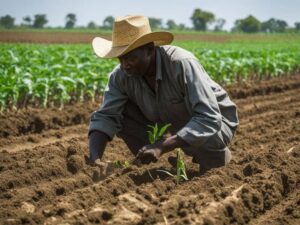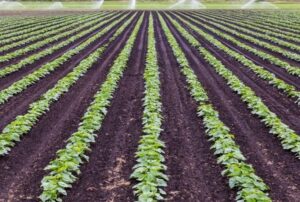5 Key Insights into Intensive Subsistence Farming
Intensive subsistence farming is an agricultural system where farmers focus on producing large amounts of food from small areas of land, often with high labor input and minimal reliance on external resources. This practice is common in densely populated areas, especially in Asia, where available arable land is limited, and labor resources are abundant.
In this blog, we will explore five key insights into intensive subsistence farming, shedding light on its characteristics, advantages, challenges, examples, and its relationship with modern farming methods.
1. What is Intensive Subsistence Farming?

Intensive subsistence farming is a method of farming that maximizes crop production on small plots of land. It is characterized by high levels of labor input and limited use of external resources such as modern machinery or chemical fertilizers. The primary goal is to produce enough food to meet the needs of the farmer’s family and local community, with little surplus for trade or sale.
This type of farming is often practiced in regions where arable land is scarce, and the population density is high, such as in parts of China, India, and Southeast Asia. The focus on maximizing yield from small areas of land makes intensive subsistence farming both efficient and labor-intensive.
Why is Intensive Subsistence Farming Important? The significance of intensive subsistence farming lies in its ability to feed large populations in densely populated areas. By optimizing available land through continuous cropping cycles, farmers are able to produce significant amounts of food, despite the constraints of limited land resources.
Additionally, this type of farming plays a critical role in maintaining the balance between food supply and population growth in regions where agricultural expansion is limited. The practice also contributes to the preservation of local agricultural knowledge, traditions, and crop varieties, which are passed down through generations.
Intensive Subsistence Farming Example
A typical example of intensive subsistence farming would be the rice paddies of Southeast Asia. These farms are often divided into small plots where rice is grown in flooded conditions, a method that requires intense labor for planting, maintaining, and harvesting crops. Farmers may also grow other crops like vegetables, fruits, and legumes between rice cycles, creating a highly diverse and productive farm system.
In countries like India, smallholder farms employ traditional techniques alongside some modern tools. This hybrid approach helps to increase yields without over-relying on external inputs like synthetic fertilizers, which may not be affordable or accessible to every farmer. The practice of growing multiple crops within the same area is another defining feature of intensive subsistence farming.
2. The Key Features of Intensive Subsistence Farming

To understand intensive subsistence farming, it is essential to recognize its main features. Here are the defining characteristics that make this farming style unique:
High Labor Intensity
One of the most notable features of intensive subsistence farming is its labor-intensive nature. Farmers must dedicate significant time and effort to their fields, working long hours to cultivate and maintain crops. This is especially true in areas where manual tools and minimal machinery are used, requiring manual labor for tasks such as planting, irrigating, and harvesting.
In areas like India and China, where labor is often inexpensive and in ample supply, intensive subsistence farming remains viable despite the high labor costs. Intensive subsistence farming example: In China, family-run farms still employ manual tools for planting rice, and workers spend hours in flooded rice paddies, ensuring the crop grows without excessive water stress.
Limited Use of External Inputs
Unlike large-scale commercial farming, intensive subsistence farming relies minimally on external inputs like chemical fertilizers, pesticides, or advanced technology. Instead, farmers often use organic methods to enhance soil fertility, such as crop rotation, composting, and using animal manure.
In some instances, farmers also practice mixed cropping, which involves growing different types of crops in the same field to improve soil health and reduce the risk of pest infestations. This strategy can increase biodiversity on the farm, which helps maintain a natural ecological balance and reduces the need for synthetic chemicals.
Reliance on Traditional Knowledge
Intensive subsistence farming is deeply rooted in traditional agricultural knowledge, passed down through generations. Farmers use locally adapted techniques and are often skilled at understanding their land and weather patterns. This deep connection with the land allows them to make precise decisions about planting times, irrigation schedules, and pest control without relying heavily on technology.
For instance, farmers in rural India often base their agricultural decisions on local knowledge of seasonal changes and natural indicators, ensuring their crops are grown at optimal times. This approach enhances crop success and ensures that farming remains sustainable over the long term.
High Crop Yield Per Acre
Despite the small land area used, intensive subsistence farming focuses on maximizing crop yield per acre. This is achieved through careful land management, crop selection, and labor-intensive farming techniques. Farmers may grow multiple crops per year, depending on the region’s climate, allowing for continuous harvests and the efficient use of the land.
Integrated Farming Systems
Another key feature of intensive subsistence farming is the integration of multiple agricultural activities. This could include crop farming, livestock rearing, aquaculture, and the cultivation of various food crops. Such diversification helps to stabilize the income of farmers and ensures a balanced diet for their families. For example, a farm might grow rice, raise chickens for eggs, and rear livestock for milk and meat. The integration of these activities makes the farm more resilient to risks like crop failure or market fluctuations.
3. Intensive Subsistence Farming Example: A Closer Look

To better understand intensive subsistence farming, let’s take a closer look at a real-life example: the rice paddies of Southeast Asia.
Rice farming in countries like Vietnam, Thailand, and Indonesia is an excellent example of intensive subsistence farming. In these regions, farmers use traditional techniques to flood rice fields, a process known as wet rice cultivation. The flooded fields provide an ideal environment for rice to grow, but they also require intensive management.
Farmers manually plant and harvest rice by hand, sometimes relying on family members and laborers from nearby communities. Despite the heavy labor required, the fields produce multiple rice crops each year. In some areas, farmers use natural fertilizers such as compost or manure to enhance soil quality.
In addition to rice, these farmers often grow a variety of other crops, including vegetables like beans, sweet potatoes, and various herbs. This diversity allows them to reduce their dependence on a single crop, increasing food security for their families. Furthermore, the use of organic methods in this system reduces the need for chemical inputs, making it more environmentally sustainable.
These traditional methods are slowly being supplemented with modern agricultural techniques. For instance, some farmers use simple irrigation pumps and may apply small amounts of chemical fertilizers to improve yields. However, the overall system remains labor-intensive and highly dependent on local knowledge and natural resources.
4. Subsistence Farming vs. Intensive Farming: What’s the Difference?

Many people confuse subsistence farming with intensive farming, but these two systems are quite different. Understanding their distinctions is essential for grasping the full scope of intensive subsistence farming and how it fits into the broader agricultural landscape.
What is Subsistence Farming?
Subsistence farming refers to an agricultural practice where farmers grow enough food to meet the needs of their own families, with little to no surplus for sale. It is primarily focused on self-sufficiency rather than profit. Farmers typically grow basic food crops such as cereals, tubers, and legumes, and often raise livestock for additional food sources.
What is Intensive Farming?
Intensive farming, on the other hand, is a commercial farming system that uses high levels of input—such as synthetic fertilizers, pesticides, and machinery—to maximize crop production. The goal is to generate profit by producing large quantities of crops or livestock from relatively small areas of land.
The key difference lies in the scale and focus of each system. Intensive farming is oriented toward large-scale, industrial production with a high degree of mechanization, whereas subsistence farming focuses on meeting the needs of the farmer and their immediate family.
Combining Both Practices
In some cases, subsistence farming and intensive farming methods may be combined, creating what is known as intensive subsistence farming. This hybrid system allows farmers to increase productivity on small plots of land using labor-intensive techniques while still focusing on self-sufficiency.
5. The Challenges and Future of Intensive Subsistence Farming

While intensive subsistence farming has many benefits, it also faces several challenges. Below, we will explore the major hurdles this farming system faces and how farmers can adapt to future changes.
Challenges of Intensive Subsistence Farming
- Soil Degradation: Intensive farming can lead to soil depletion due to the continuous cultivation of crops without sufficient rest periods. Over time, this can reduce soil fertility, making it harder to sustain high yields.
- Water Scarcity: Many areas that practice intensive subsistence farming, such as rice-growing regions, are heavily reliant on irrigation. Overuse of water resources can lead to water shortages and damage to local ecosystems.
- Labor Shortages: Since intensive subsistence farming is highly labor-intensive, there is a risk of labor shortages as younger generations move to cities for work. This could make it harder for farmers to maintain their land and keep up with agricultural demands.
- Climate Change: Changes in weather patterns, such as droughts, floods, and temperature extremes, can disrupt crop production. Farmers must adapt to new conditions, which may require changes in farming techniques or crop selection.
Adapting to Future Challenges
To overcome these challenges, farmers can implement sustainable agricultural practices such as crop rotation, organic farming methods, and the use of drought-resistant crop varieties. Additionally, technological advancements in irrigation systems and soil management can help mitigate some of the negative impacts of intensive farming.
As demand for food continues to rise, the future of intensive subsistence farming will likely involve greater integration of technology, improved farming practices, and efforts to enhance environmental sustainability.
Conclusion
In conclusion, intensive subsistence farming remains an essential agricultural practice in many parts of the world, helping to feed growing populations despite limited land resources. Its labor-intensive nature, reliance on traditional knowledge, and focus on maximizing land use are key to its success.
However, the future of intensive subsistence farming depends on the ability of farmers to adapt to challenges like soil degradation, water scarcity, and labor shortages. Through sustainable practices and the careful use of technology, intensive subsistence farming can continue to play a vital role in global food security.
If you’re interested in learning more about sustainable farming practices, including crop cultivation and advanced agricultural techniques, be sure to check out the following resources:
- Rabi Seed Information: Timing, Cultivation, and Methods
- Learn Organic Natural Farming for a Better Future
- A Comprehensive Guide for Wheat Crop Cultivation and Importance
By understanding the ins and outs of intensive subsistence farming, you can gain a deeper appreciation for how food is produced in different regions and the sustainable techniques that are vital for feeding the world today and in the future.














Post Comment